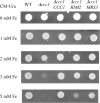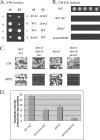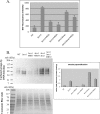Genetic and biochemical analysis of high iron toxicity in yeast: iron toxicity is due to the accumulation of cytosolic iron and occurs under both aerobic and anaerobic conditions
- PMID: 21115478
- PMCID: PMC3030386
- DOI: 10.1074/jbc.M110.190959
Genetic and biochemical analysis of high iron toxicity in yeast: iron toxicity is due to the accumulation of cytosolic iron and occurs under both aerobic and anaerobic conditions
Abstract
Iron storage in yeast requires the activity of the vacuolar iron transporter Ccc1. Yeast with an intact CCC1 are resistant to iron toxicity, but deletion of CCC1 renders yeast susceptible to iron toxicity. We used genetic and biochemical analysis to identify suppressors of high iron toxicity in Δccc1 cells to probe the mechanism of high iron toxicity. All genes identified as suppressors of high iron toxicity in aerobically grown Δccc1 cells encode organelle iron transporters including mitochondrial iron transporters MRS3, MRS4, and RIM2. Overexpression of MRS3 suppressed high iron toxicity by decreasing cytosolic iron through mitochondrial iron accumulation. Under anaerobic conditions, Δccc1 cells were still sensitive to high iron toxicity, but overexpression of MRS3 did not suppress iron toxicity and did not result in mitochondrial iron accumulation. We conclude that Mrs3/Mrs4 can sequester iron within mitochondria under aerobic conditions but not anaerobic conditions. We show that iron toxicity in Δccc1 cells occurred under both aerobic and anaerobic conditions. Microarray analysis showed no evidence of oxidative damage under anaerobic conditions, suggesting that iron toxicity may not be solely due to oxidative damage. Deletion of TSA1, which encodes a peroxiredoxin, exacerbated iron toxicity in Δccc1 cells under both aerobic and anaerobic conditions, suggesting a unique role for Tsa1 in iron toxicity.
Figures








References
-
- Touati D. (2000) Arch. Biochem. Biophys. 373, 1–6 - PubMed
-
- Valko M., Morris H., Cronin M. T. (2005) Curr. Med. Chem. 12, 1161–1208 - PubMed
-
- Pietrangelo A., Trautwein C. (2004) Nat. Clin. Pract. Gastroenterol. Hepatol. 1, 39–45 - PubMed
-
- Milgrom E., Diab H., Middleton F., Kane P. M. (2007) J. Biol. Chem. 282, 7125–7136 - PubMed
Publication types
MeSH terms
Substances
Grants and funding
LinkOut - more resources
Full Text Sources
Medical
Molecular Biology Databases
Research Materials

